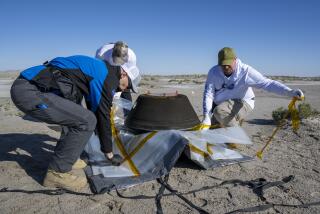Comet Collisions End With Showstoppers : Space: Drama on Jupiter called biggest event ever seen by telescopes.
- Share via
The bombardment of Jupiter climaxed late Thursday in a brutal finale to what some astronomers called the most extraordinary event in the 300 years telescopes have been trained on the gas giant.
In a thunderstorm of debris, four more fragments struck the planet, including the last of a series of mountain-sized pieces that exploded in overlapping fireballs at 10-hour intervals on the same spot. Each of the large blasts carried a force believed to be many times greater than Earth’s nuclear arsenal.
The final major piece of comet Shoemaker-Levy 9 was to hit just after midnight, completing a ring of crater-like plumes of swirling superheated gas and debris thousands of miles across.
“It hit Jupiter like a string of machine-gun bullets,” said Eugene Shoemaker, an astronomer at the Lowell Observatory in Flagstaff, Ariz., who helped discover the comet last year.
The passage of the last fragment signals the end of a celestial traveler that has circled the solar system since the creation of the planets, astronomers said. The dark plumes from the 21 fragments that hit Jupiter will remain visible for several days, even to small amateur telescopes on Earth, experts said.
In the hundreds of reports from observatories the world over and in the telemetry from five watching spacecraft, scientists may find the clues to some of the most fundamental puzzles of the planets and the solar system.
Sensors show that the impacts stirred a brimstone soup of ammonia, sulfur, hydrogen and helium in the Jovian atmosphere, scientists at NASA’s Goddard Space Flight Center in Maryland said. That might lead to a better understanding of the reds, yellows and browns of Jupiter’s signature clouds.
The comet’s passage also released electrically charged particles that kindled unusual flares in the planet’s aurora, said Renee Prange, of the French Institute Astrophysique Spatiale. That may help scientists better understand the enormous magnetic fields that protect planets such as Jupiter and Earth from solar gales of charged particles.
In the traces of molecules from the fragments, they hope to finally solve the riddle of the composition of comets, which are believed to be fossils that survived the birth of the solar system. Most scientists believe that comets are made of water, ice, rock and dust, but so far astronomers have not found any sign of water in the fireballs and gas plumes produced by the bombardment.
“We can’t understand what happened on Jupiter until we really understand what plunged into Jupiter,” said Hal Weaver at the Space Telescope Science Institute in Baltimore, underscoring the importance of determining the constituent elements of the comet. He is leading the scientists analyzing the images from the Hubble Space Telescope’s new wide field planetary camera.
The shock of the explosions also sent what appeared to be visible ripples through Jupiter’s atmosphere. Some scientists suspect they may be sonic booms or perhaps seismic waves.
“I think it is safe to say we will be arguing about all of this for years,” said Donald K. Yeomans, a comet expert at the Jet Propulsion Laboratory in Pasadena, who helped predict the pattern of impacts.
As scientists ponder their data, the comet’s trailing wings will brush the planet for weeks to come, showering it with dust, sand and boulders. It even may give Jupiter a new ring, albeit one too faint to see from Earth, astronomers said.
The shattered comet began its bombardment of Jupiter on Saturday, fragmented in what astronomers called “a string of pearls.” As it approached at speeds of 130,000 m.p.h., some fragments shifted or split up, while others disappeared and reappeared.
In the comet’s last hours, one smaller fragment that had vanished months ago enigmatically winked back into view before plunging into Jupiter’s atmosphere, leaving its audience on Earth wondering how the dark fragment suddenly lit up again. The Keck Telescope on Mauna Kea in Hawaii captured an image of the impact.
Another fragment, which was so bright that astronomers assumed it must be enormous, hit with relatively little force. Astronomers suspect it had dissolved into a swarm of pebbles and gravel in the weeks before impact.
After watching its erratic behavior carefully, some scientists suggested that Shoemaker-Levy 9 may have been near the end of its lifetime as a comet anyway, even if it had avoided the headlong plunge into the solar system’s largest planet.
Comets owe their starlight dazzle and distinctive tails to the volatile gases and dust that heats up as they swing along their orbits toward the sun. The Shoemaker-Levy fragments showed little characteristic glitter. Yeomans at JPL suggested that the absence of water in the plumes on Jupiter and the apparent fragility of the comet fragments could mean that the comet had exhausted its stores of icy chemicals and was turning into a dark asteroid.
“What really is unusual about this comet is that we got to observe it on our watch, because this only happens once every few thousand years,” Yeomans said.
“We’ll never see anything like this again. No way.”
A Fiery Life
Here are some statistics about the Shoemaker-Levy 9 comet:
Created when the planets were formed 4.5 billion years ago.
Torn apart by Jupiter in July, 1992.
Discovered in March, 1993 at Palomor Observatory.
Began bombarding Jupiter last Saturday.
Largest fragments hit with the force of 6 million megatons of TNT.
Last of 21 major fragments expected to hit at 1 a.m. PDT today.





